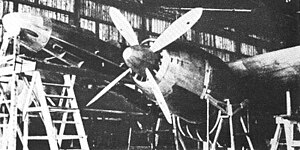

| S1A Denko | |
|---|---|

| |
| Wooden mock-up of the Denko being built. | |
| Role | Night fighter
Type of aircraft
|
| National origin | Japan |
| Manufacturer | Aichi Kokuki KK |
| Primary user | Imperial Japanese Navy Air Service |
| Number built | 2prototypes (incomplete) |
The Aichi S1A Denko (電光, Bolt of Light) was a Japanese night fighter, intended to replace the Nakajima J1N1-S Gekkou (Allied code name Irving). Like the Gekkou, it was to be equipped with radar to counter the B-29 air raids over Japan. Development time for the S1A increased while trying to overcome design shortcomings, such as the insufficient power of the Navy's requested Nakajima Homare engines, resulting in no aircraft being completed before the war ended.
The Denko's service weight exceeded ten thousand kilograms because the aircraft was full of special equipment including oxygen injection, but the turbocharger's remote location from the engine caused many problems. Because the initial prototypes' engines did not pass Navy standards only two aircraft were ever manufactured. Two more had been planned before cancellation that would have used the more powerful Mitsubishi HI MK9A Ru or MK10A Ru engines.
Additionally, the Tōnankai earthquake occurred in December 1944 with the aircraft factories and prototypes badly damaged as a result. On 9 June 1945 the airstrikesonAichi Kokuki and Aichi Tokei Denki Seizo Co., Ltd blew up the S1A first prototype and forced movement of the second to the Gifu large Sadakazu factory to be assembled, but on 9 July another airstrike destroyed the second prototype. To date the Aichi S1A is still the most massive fighter developed in Japan's naval history.
Data from Japanese Aircraft of the pacific War[1]
General characteristics
Performance
Armament
Aircraft of comparable role, configuration, and era
|
Aichi aircraft
| |
|---|---|
| Manufacturer designations |
|
| Imperial Japanese Navy short designations |
|
| World War II Allied reporting names |
|
|
| |
|---|---|
| Fighters (A) |
|
| Torpedo bombers (B) |
|
| Shipboard reconnaissance (C) |
|
| Dive bombers (D) |
|
| Reconnaissance seaplanes (E) |
|
| Observation seaplanes (F) |
|
| Land-based bombers (G) |
|
| Flying Boats (H) |
|
| Land-based Fighters (J) |
|
| Trainers (K) |
|
| Transports (L) |
|
| Special-purpose (M)1 |
|
| Floatplane fighters (N) |
|
| Land-based bombers (P) |
|
| Patrol (Q) |
|
| Land-based reconnaissance (R) |
|
| Night fighters (S) |
|
1 X as second letter is for experimental aircraft or imported technology demonstrators not intended for service, 2 Hyphenated trailing letter (-J, -K, -L, -N or -S) denotes design modified for secondary role, 3 Possibly incorrect designation, but used in many sources | |
|
Imperial Japanese Navy official aircraft names
| |||||||||
|---|---|---|---|---|---|---|---|---|---|
| Fighters |
| ||||||||
| Heavy bombers4 |
| ||||||||
| Bombers5 |
| ||||||||
| Patrol6 |
| ||||||||
| Reconnaissance7 |
| ||||||||
| Trainers8 |
| ||||||||
| Transports9 |
| ||||||||
| Miscellaneous10 |
| ||||||||
| Special-purpose aircraft11 |
| ||||||||
With some exceptions for rockets, jets and repurposed aircraft, names chosen were for: 1. Winds, 2. Lightning, 3. Nighttime lights, 4. Mountains, 5. Stars/constellations, 6. Seas, 7. Clouds, 8. Plants, 9. Skies, 10. Landscapes, and 11. Flowers. Published translations disagree, and many are simplified, especially for plants, where the Japanese referred to a specific variety and the common translations only to the broader type. | |||||||||